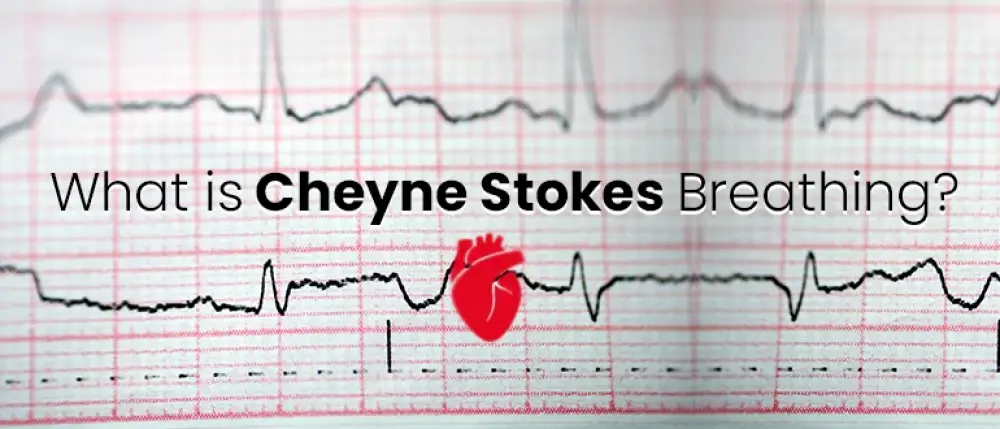Subscribe to get weekly insights
Always stay up to date with our newest articles sent direct to your inbox
Published on 14 Aug, 2024
Updated on 26 May, 2025
1929 Views
4 min Read

Written by Mudit Handa
favorite1Like
Imagine a situation when you are asleep and suddenly you start gasping for air and struggle to breathe. A pattern of such abnormal breathing is called Cheyne Stokes Breathing. It involves episodes of slow or no breathing, which may indicate an underlying medical condition. It is more common during sleep and can last up to 2 minutes.
In this blog, we will explore the causes, symptoms and treatments of the breathing disorder to gain a deeper understanding of what is Cheyne-Stokes breathing.
Cheyne Stokes respiration is a breathing disorder consisting of a periodic cycle of changing breathing patterns including:
This cycle of decreasing and increasing breathing activity happens due to the delay of signals from the brain in detecting carbon dioxide levels in the blood. This delay causes a lack of respiratory control that affects normal breathing.
Cheyne Stokes respiration is characterised by three stages as given below:
Several chronic health conditions can lead to the development of Cheyne Stokes breathing. The following are some common causes:
Cheyne Stokes breathing has symptoms similar to sleep apnea such as-
Treatment of Cheyne Stokes breathing involves addressing the underlying medical issue and treating its symptoms. It may include medication, use of breathing assistance devices and lifestyle changes. In addition, certain therapies are also helpful in treating this condition such as-
Yes, Cheyne Stokes breathing can be dangerous if left untreated. This is because the low oxygen level in blood during an episode of apnea can cause damage to the heart or disturb its rhythm which can lead to Cheyne-Stokes breathing death. It is important for patients to be aware of their symptoms and seek the right treatment for this breathing disorder, as it not only helps in relieving the symptoms but also manages the underlying health condition.
Cheyne Stokes breathing is a compensatory breathing mechanism that the brain uses to balance low oxygen levels in the blood. It is more common in patients with advanced heart failure, or a condition affecting the circulatory system or lungs. This type of breathing pattern may also be seen just before the death of a person.
The best way to prevent this breathing disorder is to maintain good health and an active lifestyle. Care health insurance provides coverage for preventive health check-ups and also covers chronic ailments under its critical illness plan. You can buy the affordable health insurance plans online through our website and get access to more than 11500 cashless network hospitals and 21700 cashless healthcare providers including IPD/OPD/Diagnostic/Pharmacy etc.
>> Also Read: What is the Importance of Heart Mediclaim?
Disclaimers: The above information is for reference purposes only. For more details about the health insurance plans and their benefits please refer to the sales prospectus, policy terms, and conditions.
Thyroid : मामूली नहीं हैं महिलाओं में थायराइड होना, जानें इसके लक्षण और घरेलू उपचार Vipul Tiwary in Diseases
शुगर कंट्रोल कैसे करे? जानें, डायबिटीज में क्या खाना चाहिए Vipul Tiwary in Health & Wellness
हाई ब्लड प्रेशर को तुरंत कंट्रोल कैसे करें? देखें इसके उपाय Vipul Tiwary in Diseases
पैरों में दर्द किस कमी से होता है? जानें, इसके घरेलू इलाज Vipul Tiwary in Health Insurance Articles
Cold Hands? Act Immediately Against Raynaud’s Phenomenon Jagriti Chakraborty in Diseases
Understanding Azotemia: Meaning, Causes, Treatment & ICD 10 Guide Leena Khowal in Diseases
Prolactin Hormone: Functions, Normal Levels, Causes, Symptoms & Treatment Guide Yashita Sinha in Diseases
Lymphatic Filariasis: The Silent Parasite Millions are Ignoring Jagriti Chakraborty in Diseases
Always stay up to date with our newest articles sent direct to your inbox
Loading...